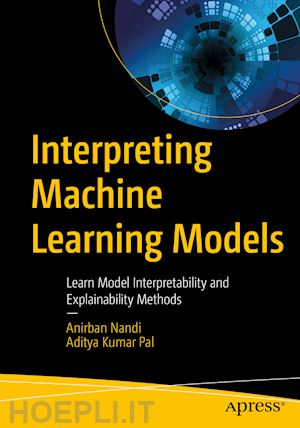
Questo prodotto usufruisce delle SPEDIZIONI GRATIS
selezionando l'opzione Corriere Veloce in fase di ordine.
Pagabile anche con Carta della cultura giovani e del merito, 18App Bonus Cultura e Carta del Docente
Understand model interpretability methods and apply the most suitable one for your machine learning project. This book details the concepts of machine learning interpretability along with different types of explainability algorithms.
You’ll begin by reviewing the theoretical aspects of machine learning interpretability. In the first few sections you’ll learn what interpretability is, what the common properties of interpretability methods are, the general taxonomy for classifying methods into different sections, and how the methods should be assessed in terms of human factors and technical requirements. Using a holistic approach featuring detailed examples, this book also includes quotes from actual business leaders and technical experts to showcase how real life users perceive interpretability and its related methods, goals, stages, and properties.
Progressing through the book, you’ll dive deep into the technical details of the interpretability domain. Starting off with the general frameworks of different types of methods, you’ll use a data set to see how each method generates output with actual code and implementations. These methods are divided into different types based on their explanation frameworks, with some common categories listed as feature importance based methods, rule based methods, saliency maps methods, counterfactuals, and concept attribution. The book concludes by showing how data effects interpretability and some of the pitfalls prevalent when using explainability methods.
What You’ll Learn
Who This Book Is For
Machine learning practitioners, data scientists and statisticians interested in making machine learning models interpretable and explainable; academic students pursuing courses of data science and business analytics.
With close to 15 years of professional experience, Anirban Nandi specializes in Data Sciences, Business Analytics and Data Engineering spanning across various business verticals, and building teams from grounds up. Following his Masters from JNU in Economics, Anirban started his career at an US based multi-channel retailer and spent more than eight years working on developing in-house products like Customer Personalization, Recommendation System and Search Engine Classifiers. Post that, Anirban became one of the founding Data Sciences and Analytics members for an organization head-quarted in UAE and spent several years building the onshore and offshore team working on Assortment, Inventory, Pricing, Marketing, Ecommerce and Customer analytics solutions. Currently, Anirban is associated with Rakuten India as the Head of Analytics developing Data Sciences and Analytics solutions for the Rakuten Global Ecosystem across different domains of Commerce, FinTech, Telecommunication, etc. He is also involved in building scalable AI products which can support the data driven decision making culture for the Rakuten Global Ecosystem.
Anirban's interests include learning about new technologies and disruptive start-ups. In his spare time he loves networking with people. On the personal side, Anirban loves sports, and is a big follower of soccer/football (Argentina and Manchester United are his favorite teams).
Email: aninandi1983@gamil.com
Linekdln: https://www.linkedin.com/in/anirban-nandi-89a36ab7/
Email – aditya.nitrr@gmail.com
Linkedin - https://www.linkedin.com/in/aditya-kumar-pal-1423624a











Il sito utilizza cookie ed altri strumenti di tracciamento che raccolgono informazioni dal dispositivo dell’utente. Oltre ai cookie tecnici ed analitici aggregati, strettamente necessari per il funzionamento di questo sito web, previo consenso dell’utente possono essere installati cookie di profilazione e marketing e cookie dei social media. Cliccando su “Accetto tutti i cookie” saranno attivate tutte le categorie di cookie. Per accettare solo deterninate categorie di cookie, cliccare invece su “Impostazioni cookie”. Chiudendo il banner o continuando a navigare saranno installati solo cookie tecnici. Per maggiori dettagli, consultare la Cookie Policy.